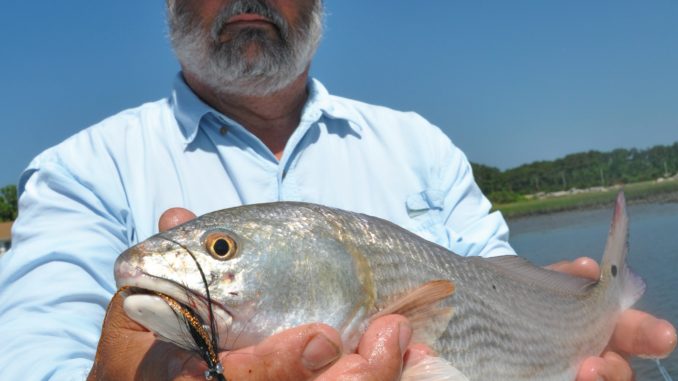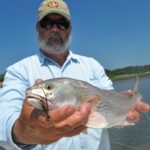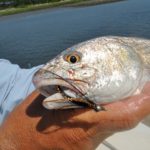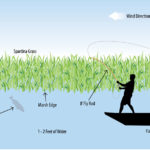
Sight-fishing makes catching redfish on a fly one of the biggest challenges a saltwater fisherman can face in North Carolina waters.
Discounting summer tarpon in Pamlico Sound, trying to catch a red drum in the marsh with a fly rod may be the ultimate challenge for saltwater fishermen in North Carolina.
Arguably, no one does it better than Joe Shute, 57, the owner of Atlantic Beach’s Cape Lookout Fly Shop, who spends most of his time tying flies for red drum, Spanish and king mackerel, albacore, amberjack, bluefish and cobia, and even builds huge trolling lures for tuna and marlin fishermen.
Although arthritis in his right shoulder limits the number of casts he makes these days — after making thousands of them for years — Shute still takes anglers to the marshes behind Morehead City and Beaufort in pursuit of red drum.
“Redfish in shallow water with a fly rod is a lot like bowhunting deer,” said Shute, who has been twice appointed to the N.C. Marine Fisheries Commission. “Nearly anyone can catch a drum with live or cut bait or artificial lures. But using a fly, well, that’s an entirely different deal. You have to be able to stalk them or sit for hours, waiting for one or two or a school.”
Leaning to use a fly rod efficiently takes time. As a New York City cab driver once told a fare who asked how to get to Carnegie Hall, “Practice.”
Shute recommends anglers talk to an expert to find the right equipment, basically to match the type of fishing to rod, reel and line requirements for the species they’ll pursue and where they’ll fish. Equipment isn’t cheap, but that depends on individual anglers. Fly rods may cost from $200 to $1,600.
“Good, medium-quality reels can cost from a low of $200 to $500,” he said. “I fish Scott and Loomis reels, but those are just personal favorites.”
Shute learned fly-rod fundamentals by attending saltwater tackle shows and watching seminars by experts. He practiced long and hard to apply what he’d absorbed.
“I learned a lot; there actually are several ways to cast flies, including overhead and at 45-degree angles,” said Shute, who chose an off-the-shoulder approach because he believes overhand casts may spook red drum and side-arm casts limit a fly-rod angler’s movements. Shute, who says he’s self-taught as a fly-caster, cut the barbs off a fly and spent hours casting in his yard.
“The main thing is get someone to show you the basic elements of fly-casting,” Shute said. “Practice 15 or 20 minutes, then quit and come back to it two hours later. If you don’t, you’ll get frustrated, and you may quit practicing as much as you should.”
Once an angler gains casting proficiency, initial trips with an expert will pay dividends in the long run.
For red drum, Shute suggests an 8- or 9-weight rod with 90-percent floating line as backing, with the last 30 feet tapered leader. then practice, practice, practice. Casting a 3- to 3 1/2-inch fly that weighs as much as a piece of crumpled tissue paper and getting it to land inside a 2-foot circle from 40 to 50 feet is the test. Then, know you’ll have to accomplish that feat with wind blowing, trying to steer your fly well off-target.
“You’re not casting heavy terminal tackle, like you would with a baitcaster or spinning rods, trying to drop a half-ounce barrel weight on the bottom, a weighted lure or throwing a popping cork toward the shoreline,” Shute said. “You need forward-weighted line, which helps, but there’s no weight except the line, and that makes it susceptible to being blown around.”
Shute prefers a black/gold Clouser fly, but some anglers like grey/white and black/orange in similar patterns. Once the fly settles on the surface, Shute strips line back in 1 1/2- to 2-foot lengths while standing at the front of his skiff.
“It really takes two people to fly fish for red drum,” he said. “The most effective way to hunt them in the marshes and creeks is to have one person poling from a platform (at the stern, above the outboard) and the other standing at the bow with the rod. (My) boat only draws about 6 inches of water, so it can get into shallow water where red fish are in spartina grass, eating the little crabs, minnows and other critters.
“Standing on a platform can make this a sight-fishing game, then it’s really fun. You’re looking down for reds in 1 to 2 feet of water. The goal is to put the fly in front of him. Best conditions are having the wind behind you because it’s hard to cast accurately into a stiff or cross wind.
“I’ve got a trolling motor, but I mostly use that to cruise marsh edges to look for fish. I usually pole while standing on the platform. It’s a good angle to see fish, but you need polarized sunglasses to see red drum in the water.”
If Shute fishes alone, he often sets up in a place he knows holds fish and uses a Power Pole to hold the boat steady.
Incoming and outgoing tides dictate best fishing periods, along with water clarity.
“The best times to fly fish for red drum — or other inside fish — is during a high, falling tide when there’s no more than 5 to 6 miles an hour of wind,” he said. “(Outgoing tides) pull the little critters out of the spartina grass and draw red drum to the edges. But a falling tide also dictates how long you can fish the grass lines. Otherwise, you’ll be too far away to cast to the edges. You also have to be aware of being caught in shallow water and not getting your boat out.”
Shute believes sunlight makes the gold flash in his Clouser flies more visible to redfish and creates more strikes, so sunny days are better than overcast.
“That’s where water clarity is important,” he said. “If water’s really dirty, fish can’t see well, so we may not go. On the other hand, red drum are spooky because you’re in 1 to 2 feet of water. If the water’s so clear you can see them, they can see you. I like water that’s a little stained.
“Good places to cast are holes in spartina grass near marsh edges and open water, and that’s why you must be able to put a fly where you want,” Shute said. “Recently though, the spartina grass here has gotten so thick on the islands that flood at high tide, it’s tough to find holes.”
Shute usually tries to cast a fly at the edge of flooded grass to draw the attention of fish as he strips line and makes his retrieve. The design of his flies helps avoid hang-ups. He uses a No. 2 hook and 5/32-ounce dumbbell eyes wrapped and glued along with the fly’s bucktail or Mylar streamers.
“The eyes make the hook ride up instead of down, so it doesn’t get hung so much,” he said.
If he hooks a red drum in flooded grass or near the edge of a marsh, the challenge is guiding a fish to open water.
“The first thing a hooked red will do is head for the spartina,” Shute said. “But a fly rod has a lot more strength than you think. Just lean sideways against his direction and guide him where you want him to go.”
A fly angler also must make sure already-stripped line is clear of obstacles.
“Clearing line is important once you set the hook. I let line feed through my left hand until I can put him on the reel after I catch up all the slack line,” said Shute, who is left-handed and will hold the rod in his right hand. “It’s like using a spinning reel for me.”
Hooking and landing a red drum with a fly rod is exactly the opposite of using a spinning or baitcasting tackle.
“When you set the hook, you want to strip the line back with the same hand you’re using to retrieve line,” he said. “The first thing you should do after your line settles on the water is point the rod at the fly and strip line back to you and let it pile up near your feet, being careful to not step on it or get your feet tangled in it.”
Shute contends retrieving a fly by stripping will make the fly bounce up and down off the bottom.
“It also moves side to side, giving it more action than a lure, but I’ve never been able to convince the artificial guys of that,” he said.
When a red drum takes a fly, the angler should make two quick 1- to 1 1/2-foot strips of line to detect the fish’s weight, then set the hook hard. Maintain contact with the drum with the line-stripping hand to keep its head pointed toward open water while reeling slack line onto the reel with the free hand. Then the angler can fight the fish with the reel.
“Lower your rod tip while you strip line back,” Shute said. “If you’ve got a strike, don’t lift up the tip at a 30- or 40-degree angle like a regular fishing rod. Point the rod tip at the line while retrieving and don’t allow slack, because a fly-rod tip flexes, and a red drum can pick up a fly and you won’t feel him. Strip line back just like you’d set the hook, only when you set the hook, strip twice.”
When the tide falls out too much in marshes and creeks and away from the spartina, Shute heads for the Intracoastal Waterway. By keeping up with reports from local fishermen, he knows which creeks and oyster beds are likely to be holding reds.
“Fishing for red drum isn’t like it used to be in the 1980s and 1990s,” he said. “People had epic days where they’d catch 15 to 25 reds on flies. These days a good day is four or five fish.”
With reds in inshore waters varying from 15 to 33 inches long, catching one on a fly rod is one of fishing’s ultimate accomplishments.
DESTINATION INFORMATION
WHERE TO GO/HOW TO GET THERE — US 70 is the main route that brings fishermen to Morehead City from most places in North Carolina. Popular public boat ramps are behind the N.C. Division of Marine Fisheries headquarters on US 70, at Radio Island between Morehead City and Beaufort, at Taylor’s Creek off Lennoxville Road in Beaufort and on the Newport River off Turner Street in Beaufort. The “Haystacks” marshes between Morehead City and the Newport River are a great spot to start, but don’t miss tributaries to Core and Adams creeks, plus Mill Creek and Harlow Creek.
WHEN TO GO — May through October.
BEST TECHNIQUES — inEight- or 9-weight fly rods with floating line and forward-weighted leaders. Joe Shute prefers to cast red drum Clouser flies in gold-and-black colors.
FISHING INFO/GUIDES — Capt. Joe Shute, Cape Lookout Fly Shop, Atlantic Beach, 252-240-1427, www.captjoes.com/capelookoutflyshop.html. See also Guides and Charters in Classifieds.
ACCOMMODATIONS — Crystal Coast Travel and Tourism, 252-726-8148, www.crystalcoastnc.org; Comfort Inn 252-247-3434, Hampton Inn, 252-240-3100, Holiday Inn Express, 252-247-5001. Atlantic Beach; Sheraton Resort, 252-240-1155, Windjammer Inn, 252-247-7123, AmeriSuites, 252-247-5118.
MAPS — GMCO Chartbook of North Carolina, 888-420-6277, www.gmcomaps.com; Capt. Segull’s Nautical Charts, 888-473-4855, www.captainsegullcharts.com; Sealake Fishihng Guides, 800-411-0185, www.thegoodspots.com.






Be the first to comment